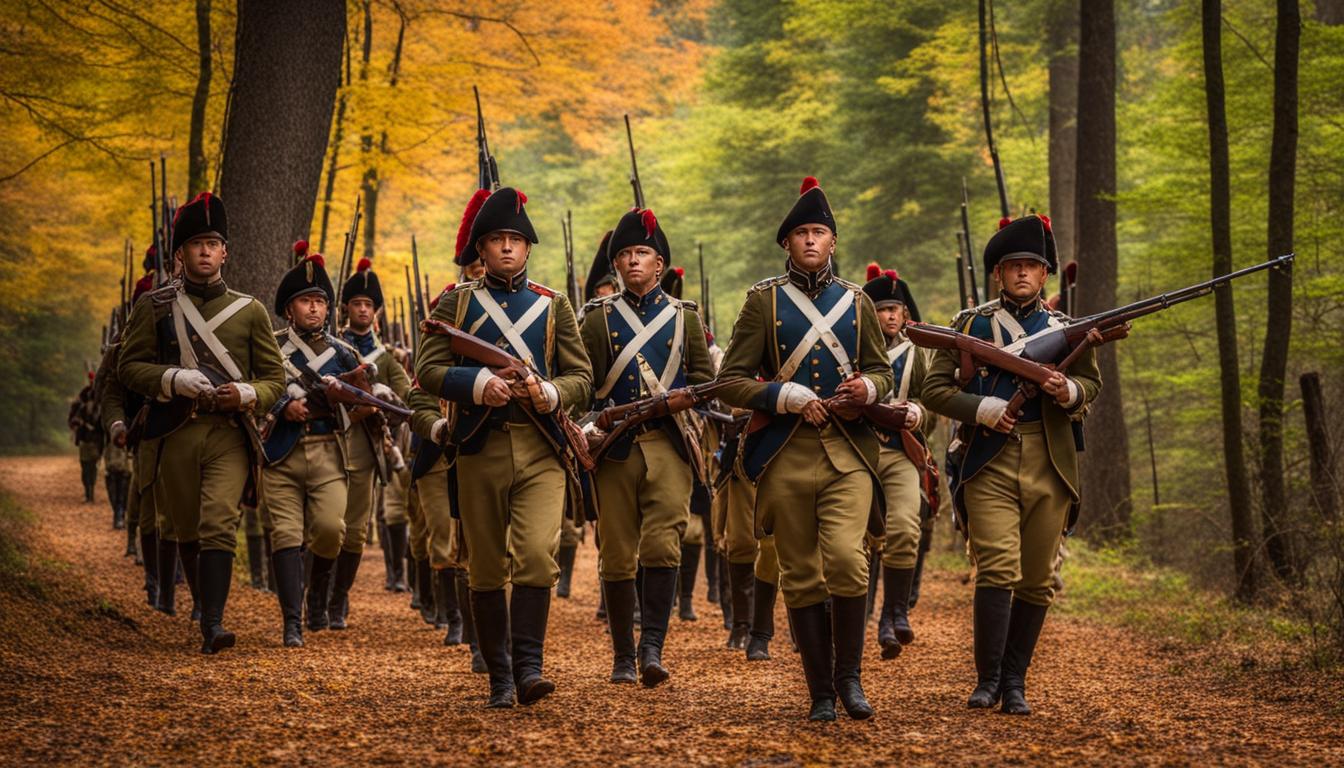In this article, I will take you on a fascinating journey through the world of Revolutionary War uniforms. We’ll delve into the different styles, materials, and influences that shaped the attire of both the British and Continental armies during this pivotal period in American history.
Key Takeaways:
- Revolutionary War uniforms played a significant role in shaping the identities and experiences of soldiers during this historic conflict.
- The early Revolutionary War saw distinct differences between British and American uniforms, with the British army favoring the iconic “red coat” and the Continental army initially wearing a patchwork of civilian clothing and militia uniforms.
- French influence brought elegance and sophistication to the evolving uniforms, with officers adopting French-inspired styles like the frock coat.
- The British army made adaptations to their uniforms for practicality and camouflage in the North American terrain.
- American soldiers introduced innovations such as hunting shirts and rifle shirts for added protection and camouflage.
Early Revolutionary War Uniforms: A Tale of Two Armies
In the early days of the Revolutionary War, the uniforms of the British and Continental armies reflected their distinct differences. The British Army, known for its standardized system, sported the iconic “red coat” as its primary uniform. Made of thick woolen broadcloth, these red coats were adorned with brass buttons, white linen facings, and white crossbelts. The British soldiers presented a formidable and uniformed front.
On the other hand, the Continental Army initially lacked a cohesive appearance. Many soldiers wore their civilian clothing or militia uniforms, resulting in a patchwork of garments on the battlefield. However, as the war progressed, the Continental Army began to adopt a more standardized attire. Blue coats became prevalent, with various facings to differentiate different branches. This transition aimed to create a more unified and disciplined army.
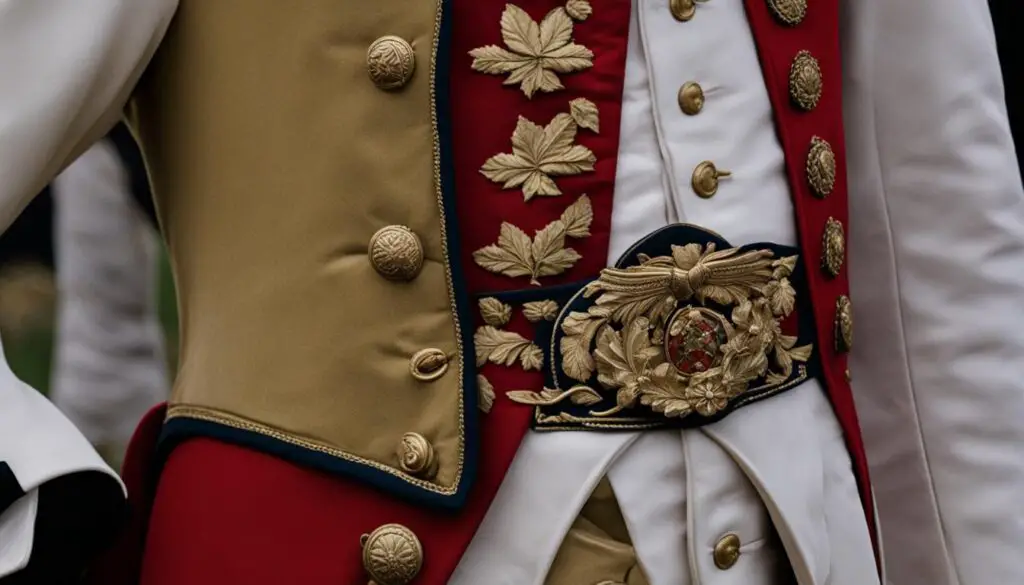
Table: Comparing British and Continental Army Uniforms
| British Army | Continental Army | |
|---|---|---|
| Main Color | Red | Blue |
| Material | Thick woolen broadcloth | Varied |
| Buttons | Brass | Varied |
| Facings | White linen | Varied |
| Uniformity | Standardized | Evolved over time |
The early Revolutionary War uniforms highlight the contrasting approaches of the British and Continental armies. While the British maintained a regimented appearance with their iconic red coats, the Continental soldiers initially lacked uniformity. However, as the war progressed, the Continental Army made efforts to standardize their attire. This shift marked the beginning of a transformation in both armies’ uniforms, setting the stage for the evolution to come.
French Influence and Evolving Styles
As the Revolutionary War continued, the uniforms of both the British and American armies evolved. One major influence was the entry of France into the war, which brought a new level of sophistication and elegance to the uniforms. Many American officers started to adopt French-inspired styles, such as the frock coat, which became the standard uniform for officers. These coats were made of blue wool with white, red, or buff facings, and often featured gold or silver lace and epaulettes. Soldiers also replaced their tricorn hats with the French bicorne hat, adorned with a decorative cockade.
The French influence on American uniforms was not limited to officers alone. The soldiers in the Continental Army also began to incorporate French-inspired elements into their attire. The coat design became more standardized, with blue coats and various facings to distinguish different branches. This uniformity helped create a sense of unity among the troops and reflected their growing professionalism.
The evolving styles in Revolutionary War uniforms not only showcased a changing aesthetic but also represented a shift in tactics and military strategy. The adoption of French-inspired uniforms was not just a fashion statement; it was a deliberate choice to align with the military prowess and expertise of their French allies. By emulating the French style, American officers hoped to project strength, professionalism, and sophistication on the battlefield.
| French-Inspired Revolutionary War Uniform Elements | Description |
|---|---|
| Frock Coat | A knee-length coat made of blue wool with white, red, or buff facings. Often adorned with gold or silver lace and epaulettes to signify rank. |
| Bicorne Hat | A two-cornered hat worn by both officers and soldiers, replacing the tricorn hat. Adorned with a decorative cockade. |
| Standardized Design | The adoption of blue coats with various facings helped create a standardized appearance among Continental Army soldiers, fostering a sense of unity and professionalism. |
British Adaptations: Practicality and Camouflage
During the Revolutionary War, the British Army made strategic adaptations to their uniforms in order to improve practicality and camouflage in the North American terrain. These changes allowed the British soldiers to navigate the forests and landscapes more efficiently, giving them an advantage in the war. The adaptations were aimed at enhancing their overall functionality and effectiveness.
To better suit the conditions in North America, the British Army opted for lighter-weight materials in their uniforms. The thick woolen broadcloth of the traditional red coat was replaced with fabrics that were more suitable for the local climate. The simpler designs not only provided practicality but also made it easier for the soldiers to move and maneuver during battles.
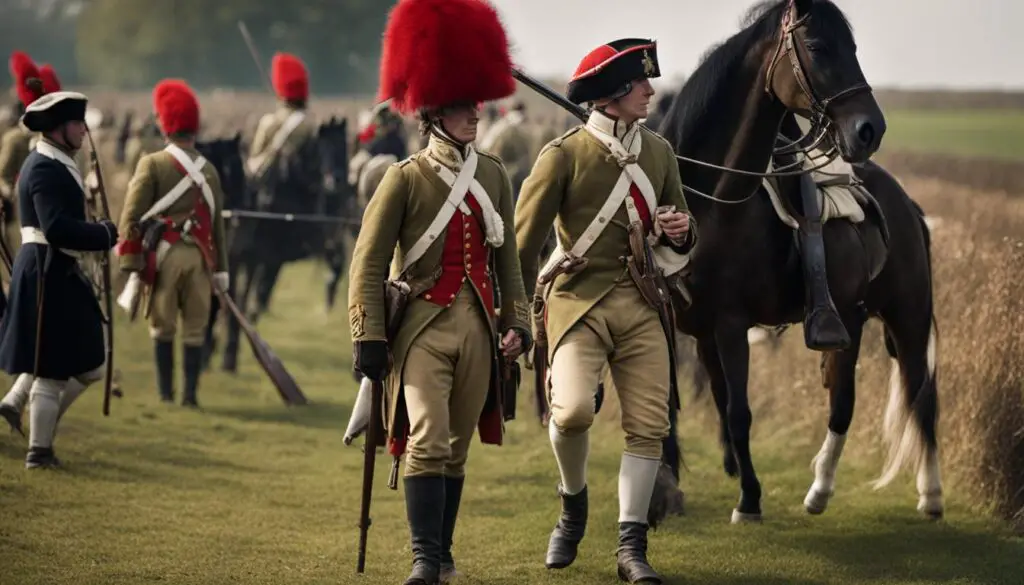
One of the most notable adaptations was the incorporation of more green and brown hues into the uniforms. This change aimed to provide better camouflage in the forests and terrain of the colonies. By blending in with their surroundings, the British soldiers could effectively hide from their enemies and strike at opportune moments.
In addition to changes in materials and colors, some British units even adopted Native American dress for increased practicality. This included wearing moccasins and leggings, which allowed for more efficient movement through challenging terrain. These adaptations demonstrated the British Army’s commitment to adapting to the unique challenges posed by the Revolutionary War.
Table: British Army Uniform Adaptations
| Adaptation | Description |
|---|---|
| Lighter-weight Materials | Replacing the thick woolen broadcloth of the traditional red coat with fabrics more suitable for the local climate. |
| Simpler Designs | Creating uniforms that provided practicality and ease of movement during battles. |
| Camouflage Colors | Incorporating more green and brown hues to blend in with the forests and terrain of the colonies. |
| Native American Dress | Adopting elements of Native American dress, such as moccasins and leggings, for more efficient movement. |
American Innovation: Hunting Shirts and Rifle Shirts
American soldiers during the Revolutionary War introduced innovative elements into their uniforms that reflected their unique circumstances and needs on the battlefield. One notable innovation was the use of hunting shirts and rifle shirts, which became staple garments for many soldiers. These loose-fitting, long-sleeved shirts were typically made from linen or homespun cloth, providing both comfort and functionality in the rugged conditions of war.
The hunting shirt, also known as a rifle shirt, offered several advantages to the American soldiers. Firstly, it provided additional protection when worn over the uniform coat, shielding the body from the elements and helping to absorb the recoil of the musket. The loose fit allowed for ease of movement, which was crucial when navigating through dense forests and rough terrain. Additionally, the muted colors such as brown, green, or gray, in which hunting shirts were often dyed, helped to camouflage the soldiers in the North American wilderness, making them less visible to the enemy.
These shirts also featured practical design elements. Some hunting shirts had decorative fringe along the sleeves and bottom hem, which served practical purposes such as wicking away rain and moisture. This feature not only enhanced the functionality of the garment but also added a touch of individuality to the uniform, allowing soldiers to express their sense of identity amidst the chaos of war.
| Hunting Shirts | Rifle Shirts |
|---|---|
| Loose-fitting | Loose-fitting |
| Made of linen or homespun cloth | Made of linen or homespun cloth |
| Provides added protection and camouflage | Provides added protection and camouflage |
| Dyed in muted colors | Dyed in muted colors |
| Some feature decorative fringe | Some feature decorative fringe |
These hunting shirts and rifle shirts embody the resourcefulness and ingenuity of the American soldiers during the Revolutionary War. They not only provided practical advantages on the battlefield but also served as symbols of resilience and adaptability in the face of adversity.
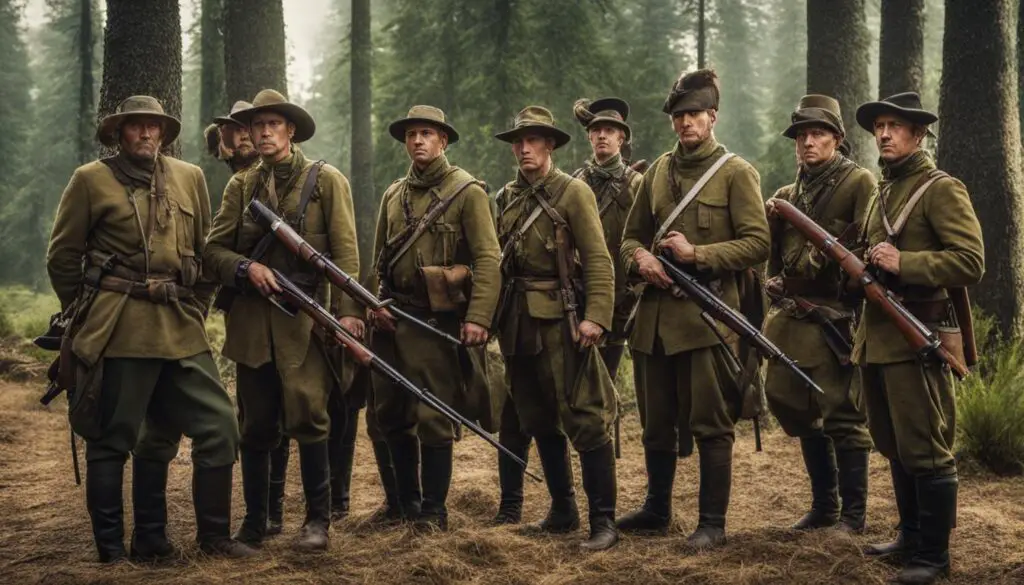
Women on the Home Front
During the Revolutionary War, women made significant contributions both on and off the battlefield. While they were not officially enlisted as soldiers, some women disguised themselves as men and fought alongside their male counterparts. These brave women adopted the same uniforms as the men, demonstrating their commitment to the cause of independence. They became known as camp followers and provided vital support services such as cooking, laundry, and nursing.
Off the battlefield, women played a crucial role in supporting the war effort by making and repairing uniforms for soldiers. They utilized their sewing skills to ensure that the troops were properly clothed, even amidst limited resources. Women also worked tirelessly to produce the cloth and materials needed for uniforms. They used spinning wheels and looms to create fabrics and contributed to the overall clothing support system for the Revolutionary War.
Women’s contributions to the Revolutionary War were invaluable, as they played a significant role in sustaining the soldiers and the war effort. Their dedication and resourcefulness exemplified the spirit of patriotism and resilience that defined the American Revolution. Their efforts not only helped to clothe the troops but also served as a symbol of their unwavering support for the cause of independence.
Women’s Contributions to the Revolutionary War: A Snapshot
| Roles | Contributions |
|---|---|
| Camp followers | Provided essential support services such as cooking, laundry, and nursing |
| Uniform production | Made and repaired uniforms for soldiers |
| Cloth production | Used spinning wheels and looms to produce fabric and materials for uniforms |
These women displayed immense courage and resilience, often risking their lives to support the cause of freedom. The contributions of these unsung heroes deserve recognition and appreciation, as they played a vital role in shaping the outcome of the Revolutionary War.
British Army Uniform Example
The British army uniform during the Revolutionary War exemplified their military might and authority. It consisted of a distinctive red coat made of thick woolen broadcloth, featuring brass buttons and white linen facings. The white crossbelts added a touch of elegance to the overall uniform. The officers had more elaborate uniforms, which included gold or silver lace and epaulettes to signify their rank. They also wore tricorn hats adorned with a black cockade, symbolizing loyalty to the British crown. Completing the attire were white breeches with black gaiters or leggings.
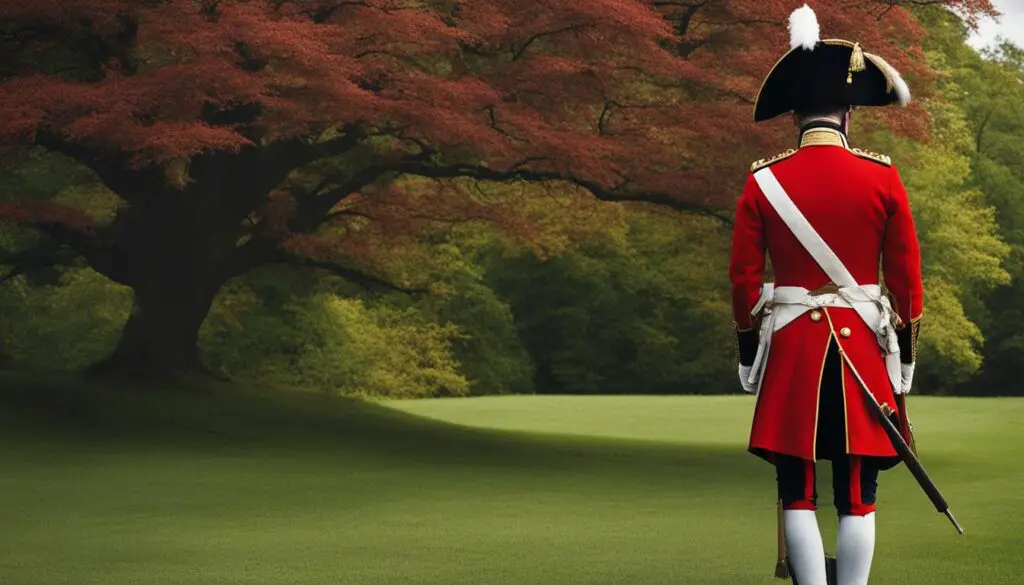
Although the British army uniform was visually striking, it also had practical and functional elements. The thick woolen broadcloth provided insulation during colder weather, while the white facings and crossbelts enhanced visibility on the battlefield. The officers’ decorations and rank insignia emphasized their command and authority, instilling a sense of discipline and hierarchy among the troops.
The uniform represented a symbol of British military tradition and power. Its recognizable red color became synonymous with the British forces during the Revolutionary War. Despite its distinct appearance, the uniform was not without its challenges. The red coat made soldiers highly visible targets, especially in open battlefields. Additionally, the weight and bulkiness of the uniform posed challenges during long marches and in restrictive environments like dense forests.
Table: Comparison of British Army Uniform Examples
| Aspect | British Army Uniform |
|---|---|
| Primary Color | Red |
| Main Material | Thick Woolen Broadcloth |
| Buttons | Brass |
| Facings | White Linen |
| Accessories | White Crossbelts, Tricorn Hat, Breeches, and Gaiters |
| Officers’ Decorations | Gold or Silver Lace, Epaulettes, Black Cockade |
Continental Army Uniform Example
During the Revolutionary War, the Continental Army went through various transformations when it came to their uniforms. Initially, there was a patchwork appearance among the soldiers, with many wearing civilian clothing or militia uniforms. However, as the army grew more organized, a more standardized uniform began to take shape.
The Continental Army uniform consisted of a blue coat with various facings to distinguish different branches. For example, artillery soldiers had red facings, infantry soldiers had white facings, and other branches had green or yellow facings. This allowed for easy identification on the battlefield. The soldiers also wore tricorn hats, which were wide-brimmed hats with three corners, offering protection from the elements. Additionally, they wore white or beige breeches and leggings or gaiters to protect their legs.
By adopting a more standardized uniform, the Continental Army was able to project a unified image and instill a sense of pride and identity among their soldiers. The uniform not only served a practical purpose but also served as a symbol of the army’s commitment to the cause of independence.
Continental Army Uniform Details:
| Uniform Element | Description |
|---|---|
| Coat Color | Blue |
| Facings |
|
| Headgear | Tricorn hat |
| Legwear |
|
During the Revolutionary War, the Continental Army adopted a more standardized uniform to create a cohesive and identifiable image. The blue coat with various facings, such as red for artillery and white for infantry, allowed for easy recognition on the battlefield. The soldiers wore tricorn hats, which were a popular style at the time, and white or beige breeches with leggings or gaiters to protect their legs. This uniform not only served a practical purpose but also fostered a sense of unity and pride among the soldiers. It symbolized their commitment to the cause of independence and their role in shaping the future of the United States.
Continental Army Uniform Details:
| Uniform Element | Description |
|---|---|
| Coat Color | Blue |
| Facings |
|
| Headgear | Tricorn hat |
| Legwear |
|
Revolutionary War Uniform Equipment and Weapons
When it came to equipping and arming themselves for battle, soldiers in the Revolutionary War carried a range of essential items. Their equipment and weapons played a crucial role in their effectiveness on the battlefield. Let’s take a closer look at the key items used by both the British and American armies during this historic conflict.
The musket was the primary weapon used by soldiers in the Revolutionary War. The British army utilized the second model Brown Bess musket, which was known for its reliability and accuracy. This smoothbore musket had a flintlock ignition system, allowing soldiers to fire a single shot before reloading. On the other hand, the Continental army used the M1766 Charleville musket, a French-made firearm that also featured a flintlock mechanism.
In addition to their muskets, soldiers carried a variety of equipment to support their needs on the battlefield. Each soldier had a knapsack, a large backpack that held spare clothing, personal items, and other essentials. They also carried a haversack, a small bag used to carry food rations and eating utensils. Canteens were another essential item, providing soldiers with a means to carry liquids, especially water, to stay hydrated during long marches and battles.
To ensure a continuous supply of ammunition, soldiers carried cartridge boxes that held pre-rolled paper cartridges. These cartridges contained a measured amount of gunpowder and a musket ball, allowing soldiers to quickly reload their muskets during combat. This efficient system saved time on the battlefield and increased the rate of fire for both the British and American armies.
“The musket was not only a weapon but also a symbol of revolution. It represented the power of the people fighting for their freedom.”
Revolutionary War Uniform Equipment and Weapons
| Item | British Army | Continental Army |
|---|---|---|
| Musket | Second Model Brown Bess | M1766 Charleville |
| Knapsack | Carried spare clothing and personal items | Carried spare clothing and personal items |
| Haversack | Contained food rations and eating utensils | Contained food rations and eating utensils |
| Canteen | Used to carry liquids, especially water | Used to carry liquids, especially water |
| Cartridge Box | Held pre-rolled paper cartridges for muskets | Held pre-rolled paper cartridges for muskets |
Conclusion
The Revolutionary War uniforms worn by both the British and American armies hold immense significance in understanding the brave soldiers who fought for independence. These uniforms served as more than just clothing; they represented military tradition, cultural influences, and adaptation to the unique challenges of the war.
Studying these iconic garments provides us with deep insights into the lives of the men and women who played pivotal roles in the American Revolution. These uniforms reflect not only the struggle for independence but also the ingenuity, resourcefulness, and adaptability of those who fought for their beliefs.
Through the diverse and evolving Revolutionary War uniforms, we witness the enduring symbols of bravery and sacrifice. These garments serve as a lasting reminder of the immense contributions made by the soldiers who fought for their ideals during this transformative period in history.
FAQ
What was the uniform of the British Army during the Revolutionary War?
The British Army wore a red coat made of thick woolen broadcloth, with brass buttons, white linen facings, and white crossbelts.
How did the Continental Army uniforms evolve during the Revolutionary War?
Initially, the Continental Army had a patchwork appearance, but as the conflict progressed, they adopted a more standardized appearance with blue coats and various facings to distinguish different branches.
How did French influence impact Revolutionary War uniforms?
French-inspired styles, such as the frock coat, became popular among American officers, with blue wool, white, red, or buff facings, and gold or silver lace and epaulettes.
Did the British Army make any adaptations to their uniforms during the Revolutionary War?
Yes, the British Army made adaptations to better suit the conditions in North America, such as using lighter-weight materials, simpler designs, and incorporating more green and brown hues for better camouflage.
What were hunting shirts and rifle shirts, and how did they contribute to American Revolutionary War uniforms?
Hunting shirts and rifle shirts were loose-fitting, long-sleeved shirts made from linen or homespun cloth. They provided added protection and camouflage when worn over the uniform coat.
What role did women play in the Revolutionary War uniforms?
Women supported the war effort by making and repairing uniforms, producing cloth and materials, and serving as camp followers, providing essential support services.
Can you describe the British army uniform during the Revolutionary War?
The British army uniform consisted of a red coat made of thick woolen broadcloth, with brass buttons, white linen facings, white crossbelts, and tricorn hats adorned with a black cockade.
Can you describe the Continental army uniform during the Revolutionary War?
The Continental army uniform consisted of a blue coat with various facings, such as red for artillery, white for infantry, and green or yellow for other branches. They also wore tricorn hats, white or beige breeches, and leggings or gaiters.
What equipment did soldiers have with their Revolutionary War uniforms?
Soldiers carried knapsacks, haversacks, canteens, and cartridge boxes. The British army used the Brown Bess musket, while the Continental army had the M1766 Charleville.
What is the significance of Revolutionary War uniforms?
Revolutionary War uniforms symbolize bravery, sacrifice, military tradition, and reflect the ingenuity, resourcefulness, and adaptability of the soldiers who fought for independence.
Source Links
- https://www.si.edu/object/george-washingtons-uniform:nmah_434863
- https://ufpro.com/blog/american-revolutionary-war-study-military-uniforms-across-battlefield
- https://www.defense.gov/Multimedia/Experience/Common-Threads/Common-Threads-Army/
